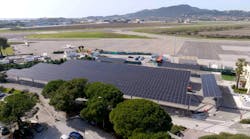SCOTTSDALE, AZ — The Scottsdale Air Center here is one of a chain of fixed base operations in the U.S. that is operated under the umbrella of Ross Aviation, based in Denver and headed up by Jeff Ross. According to its website, Ross Aviation seeks to build a group of 20 or more FBOs, with acquisitions led by Jeff Ross [no relation].
The chain takes a different approach to branding its outlets, targeting Ross Aviation nationally while maintaining local identification — with names such as Million Air Palm Springs; Premier Jet; and Bradley Pacific.
Explains Scottsdale Air Center GM Tommy Walker, “After they bought this I had a conversation with Jeff and he brought their philosophy to me, and I thought it was a good idea because we work hard to maintain that identity. Take a Bradley Pacific in Hawaii, for instance; while people may not know who Ross is they know that FBO that’s been there 20 or 30 years. They’ve been successful in maintaining that.
“They’ve got a national marketing program. Fabio Alexander out of Opa Locka [FL] does the Ross aviation marketing. Like at NBAA, where we had all of our FBOs down an aisle that looks like a runway. It shows that we’re independent, but it shows we’re a group.
“Now, each one of the FBOs also has its own marketing. Our market may be different versus Miami. The people that fly into here, I know where they’re from. We know where to reach them; and we literally knock on doors.”
Walker joined the Scottsdale Air Center just prior to its opening at the Scottsdale Airport in March, 2002. He had spent much of his 47-year career with the Toyota flight department at Long Beach, CA and with its FBO there, AirFlite. In 2006, Ross Aviation purchased he Sante Fe Jet Center and SAC, and brought on Walker as GM.
Besides marketing, Ross Aviation also brings impacted everyday management, says Walker. “Greg and Jeff have brought efficiency to the operation — the amount of people and what you can do by cross-training. They also believe in keeping up the facilities. Our capital expenditure per year is significant in order to maintain this gorgeous FBO.
“The other thing is, we have two general manager meetings a year. Everything is allowed to be put on the table and you learn from the different FBOs. They listen, and take things back and incorporate items into the whole system. It really seems to work.
“It also makes the Ross Aviation group a strong organization internally.”
A $40 million investment
According to Walker, Ross Aviation has some $40 million invested on the 18-acre leasehold at Scottsdale. It includes some 175,000 square feet of hangar space and 40,000 square feet of office space, and various corporate tenants that utilize Gulfstreams, Learjets, Falcons, Hawkers, and the like. The FBO is nine years into a 20-year lease that has two ten-year options, and fuel storage of 60,000 gallons of jet-A and 20,000 gallons of avgas.
Scottsdale Air Center is primarily a line services/property management FBO, and Walker says his operation has about half the retail fuel sales on the airport, with Landmark Aviation the competition. “In 2007-2008, we were well over 12 million gallons a year,” relates Walker. “It’s down to about seven million for the airport as a whole.”
That does not include another two million gallons per year pumped by corporate tenants in an adjacent Airpark. Growth around the airport has been rapid over the past 15 years, says Walker, and a recent study indicates that the airport generates more than $182 million annually in revenue to the region’s economy and the combined annual impact of the airport/airpark is some $2.5-3.0 billion.
At times neighbors and the airport have been at odds; however, Walker says it is a new environment today. He attributes that partly to a move to increase the landing weight at Scottsdale to 100,000 pounds to cater to international bizjets — a target of the operators and the city.
Says Walker, “The perception was the bigger airplanes will bring greater noise. We were able to prove to them that it wasn’t the case, that the newer airplanes are quieter. So, most of that has gone away.
“Now, our volume here of takeoffs and landings has decreased because of the economic situation. But everybody is working together.
“We have Customs. People can now overfly into here from Mexico; they used to have to stop at the border.
“The city and the airport, and the airport director Gary Mascaro, have been very supportive of all the activities on the airport, to the point that they’re going to have an air fair/fly-in in November here, the first one since 2001.”



